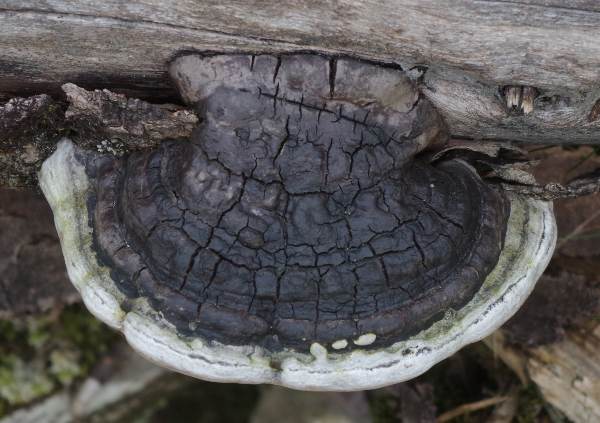Phellinus populicola Niemelä
Phylum: Basidiomycota - Class: Agaricomycetes - Order: Polyporales - Family: Hymenochaetaceae
Distribution - Taxonomic History - Etymology - Identification - Culinary Notes - Reference Sources

The fact that this bracket fungus was separated from the many other similar black, crack-topped bracket fungi as recently as 1975 should be a clear sign that its identification is fraught with difficulties. The drab appearance of these brackets does not make them easy to spot either.
Distribution
A very rare find in Britain and Ireland, this bracket fungus occurs throughout much of Scandinavia, but even there it is not often recorded.
The picture shown above, which was taken in Norway, was kindly contributed by Arnor Gullanger.
Taxonomic history
This tough bracket fungus was first described scientifically in 1975 by the Finnish mycologist Tuomo Niemelä, who gave it the binomial scientific name Phellinus populicola.
As far as I can determine the only synonym of Phellinus populicola is Ochroporus populicola (Niemelä) Fiasson & Niemelä.
Etymology
In 1886 the genus Phellinus was circumscribed by French mycologist Lucien Quélet; the generic name comes from phell- meaning cork, while the suffix -inus denotes a superlative. The implication, therefore, is that fungi in the genus Phellinus are the most cork-like (the toughest) of them all. The specific epithet populicola indicates that this wood-rotting fungus consumes the wood of poplar trees.
Identification guide
 |
FruitbodyUpper surface blackish, eventually developing a network of cracks; softer outer margin remaining whitish even on very old fruitbodies; usually 5 to 15cm across, concentrically ridged in annual layers; projecting 5 to 10cm from the substrate. The flesh inside these brackets is very hard. Occasionally, very old specimens 25-30cm in diameter and 15 to 20cm thick are encountered in Scandinavian countries. |
Tubes and PoresThe tubes are brown, and spaced at 4 to 6 per mm; they terminate in round or slightly ellipsoidal grey-brown to cinnamon-brown pores typically 0.12mm in diameter.. |
|
BasidiaClavate, four-spored. SporesSubspherical, smooth, 5-6 x 4-5μm; hyaline; inamyloid. Spore printWhite. |
|
Odour/taste |
Not significant. |
Habitat & Ecological role |
Parasitic on large poplars and Aspen, usually continuing as a saprobe for several years after the tree has died. |
Season |
Perennial, releasing spores throughout summer and autumn. |
Similar species |
Fomes fomentarius is similarly hoof shaped with an overall grey appearance, rarely cracking extensively on its upper surface; it attacks mainly birches in Britain and Ireland. |
Culinary Notes
Phellinus populicola is a tough inedible fungus - even removing one of these brackets from a tree requires a saw and would consume far more calories that would be obtained if you managed to chew and swallow it.
Reference Sources
Dictionary of the Fungi; Paul M. Kirk, Paul F. Cannon, David W. Minter and J. A. Stalpers; CABI, 2008
Taxonomic history and synonym information on these pages is drawn from many sources but in particular from the British Mycological Society's GB Checklist of Fungi.
Fascinated by Fungi. Back by popular demand, Pat O'Reilly's best-selling 450-page hardback book is available now. The latest second edition was republished with a sparkling new cover design in September 2022 by Coch-y-Bonddu Books. Full details and copies are available from the publisher's online bookshop...

